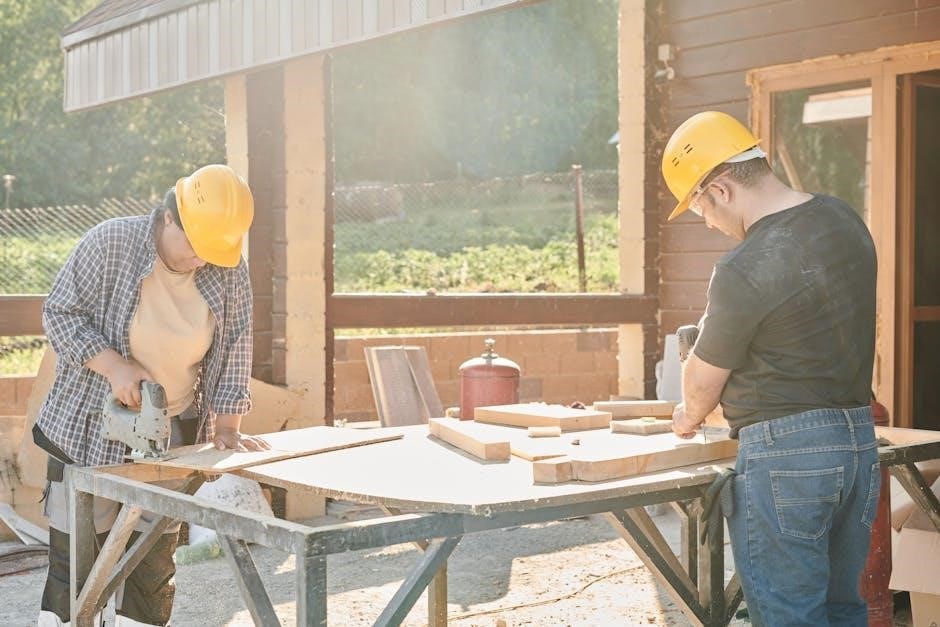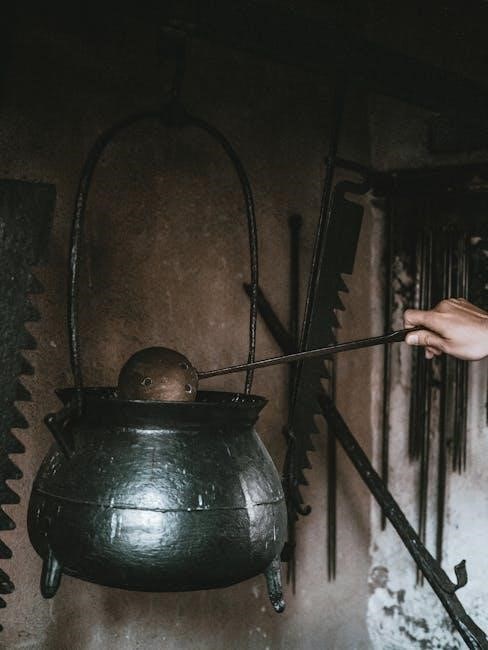Welcome to the Old Craftsman Scroll Saw Manual, your comprehensive guide to understanding and operating vintage Craftsman scroll saw models like the 113․235501 and 137․216100․
Overview of the Craftsman Scroll Saw Models
The Craftsman scroll saw lineup includes iconic models like the 113․235501 and 137․216100, known for their durability and precision․ These models are popular among hobbyists and professionals for intricate cutting tasks․ The 113․235501 features a 16-inch throat capacity and variable speed control, making it ideal for detailed woodworking․ The 137․216100 model offers similar capabilities with enhanced stability and a user-friendly design․ Both models support pin-end or plain-end blades, allowing versatility in cutting various materials, including wood, metal, and plastic․ These vintage machines are celebrated for their reliability and adaptability, making them a staple in many workshops․ Their enduring popularity underscores their value as essential tools for craftsmanship․
Importance of the Manual for Proper Operation
The Old Craftsman Scroll Saw Manual is essential for safe and effective operation of models like the 113․235501 and 137․216100․ It provides detailed instructions for assembly, operation, and maintenance, ensuring optimal performance․ The manual highlights critical safety rules, such as wearing ANSI Z87․1-compliant safety goggles and proper workpiece feeding to avoid binding․ By following the guidelines, users can prevent damage to the tool and workpiece while achieving precise cuts․ Understanding the manual’s content is vital for troubleshooting common issues and maximizing the scroll saw’s capabilities; It serves as a cornerstone for both novice and experienced craftsmen to master their equipment efficiently and safely․

Safety Instructions
Always wear ANSI Z87․1-compliant safety goggles and ensure loose clothing is tied back․ Keep hands away from the blade and maintain a firm grip on the workpiece․
- Avoid distractions while operating the scroll saw․
- Never leave the tool unattended while it is in operation․
- Ensure the work area is well-lit and free from clutter․
General Safety Precautions
Safety is a combination of common sense, staying alert, and understanding how your scroll saw works․ Always wear ANSI Z87․1-compliant safety goggles to protect your eyes from debris․ Tie back loose clothing or long hair, and avoid wearing jewelry that could get caught in the blade․ Keep your work area clean and well-lit to prevent accidents․ Ensure the scroll saw is placed on a stable, flat surface and securely anchored to prevent movement during operation․ Never leave the tool unattended while it is running, and keep children and pets away from the work area․ Disconnect the power cord when servicing or changing blades to avoid accidental start-ups․ Regularly inspect the tool for damage or wear and address issues promptly to ensure safe operation․
- Keep hands and fingers away from the blade at all times․
- Avoid operating the scroll saw if fatigued or under the influence of medications․
- Use only approved Craftsman replacement parts to maintain safety standards․
Specific Safety Guidelines for Scroll Saw Operation
Always wear safety goggles meeting ANSI Z87․1 standards to protect your eyes from flying debris․ Ensure the workpiece is securely clamped or held firmly to prevent sudden movement․ Never reach over the blade while the saw is in operation, as this can lead to serious injury․ Use a push stick or other auxiliary aid when cutting small or irregularly shaped pieces․ Keep loose clothing and long hair tied back to avoid entanglement with moving parts․ Only use blades specifically designed for scroll saws, as other types may cause unsafe operating conditions․ Always refer to the manual for model-specific safety recommendations, such as those for the Craftsman 137․216100 or 113․235501․
- Avoid operating the saw if fatigued or under medication․
- Ensure the blade is correctly installed and tightened before use․
- Keep children and pets away from the work area․

Parts and Accessories
Explore the essential components and accessories for your vintage Craftsman scroll saw, including blades, saw tables, and dust collection systems, to enhance performance and safety․
Key Components of the Craftsman Scroll Saw
The Craftsman scroll saw features a durable 16-inch cast-iron saw table for stability and smooth operation․ The 1/9 HP motor provides consistent power, while the variable speed control allows adjustments between 400-1600 strokes per minute․ The tilting arm enables precise angle cuts, and the blade mechanism supports both pin-end and plain-end blades; Additional components include a dust collection system and a control panel with an on/off switch and speed dial․ These parts work together to ensure accurate and efficient cutting, making the Craftsman scroll saw a versatile tool for intricate woodworking projects․
Accessories and Replacement Parts
The Craftsman scroll saw can be enhanced with various accessories to improve functionality․ Genuine Craftsman replacement parts, such as blades, motors, and saw tables, ensure optimal performance․ Pin-end and plain-end blades are available for different cutting needs․ A dust collection system can be added to reduce debris and improve visibility․ Safety accessories, like ANSI Z87․1-compliant safety goggles, are essential for protecting the user․ Sears offers a wide range of compatible parts and tools for these models, including the 113․235501 and 137․216100․ Regularly updating and maintaining these components ensures the scroll saw operates efficiently and safely for years to come․

Assembly and Installation
Attach the saw table securely to the base and ensure all parts are tightly fastened․ Follow the manual’s instructions for proper assembly and alignment․ Test the scroll saw after installation to ensure smooth operation․ Always align the blade correctly before first use․
Step-by-Step Assembly Guide
- Begin by carefully unboxing and inventorying all components, including the base, saw table, and hardware․
- Attach the saw table to the base using the provided bolts, ensuring it is level and securely fastened․
- Tighten all parts firmly, following the manual’s torque specifications to avoid damage․
- Align the blade holder and tensioning mechanism according to the manufacturer’s instructions․
- Connect the power cord and ensure all electrical connections are secure and meet safety standards․
- Test the scroll saw at a low speed to verify proper assembly and functionality before full operation․
Always refer to the safety guidelines and manufacturer’s instructions for specific assembly details․
Installing the Scroll Saw Blade
To install the scroll saw blade safely and effectively:
- Wear safety goggles to protect your eyes from debris․
- Locate the upper and lower blade holders on the front and back of the saw․
- Open the blade holders by turning the tension knob or lever to release the tension․
- Insert one end of the blade into the upper holder and the other into the lower holder, ensuring the teeth face upward for standard use․
- Tighten the blade holders securely with an Allen wrench to prevent slippage, avoiding over-tightening․
- Adjust the tension knob to achieve proper blade tautness for accurate cuts and to prevent breakage․
- Align the blade properly to ensure straight cutting and accurate tracking․
- Test the installation by making a small cut on scrap wood to verify blade performance and adjust as necessary․
Ensure you use the correct blade type for your model and replace blades when they become dull for optimal performance․

Operating Instructions
Turn on the scroll saw, adjust the variable speed setting for your material, and gently feed the workpiece into the blade, maintaining steady control throughout the cut․
Starting the Scroll Saw for the First Time
Before starting, ensure you wear safety goggles and read the manual thoroughly․ Familiarize yourself with the tool’s components and controls․ Plug in the saw, ensure the work area is clear, and check the blade tension․ Turn on the power and allow the motor to reach its operating speed․ Perform a test run without a workpiece to ensure smooth operation․ Once satisfied, proceed with your first cut, following the guidelines for material feeding and blade alignment․ Proper preparation ensures safe and efficient use of your Craftsman scroll saw․
Adjusting the Variable Speed Setting
The variable speed setting on your Craftsman scroll saw allows you to customize the blade’s RPM (revolutions per minute) for optimal cutting performance․ To adjust, locate the speed control dial, typically positioned on the front or top of the saw․ Turn the dial clockwise to increase speed or counterclockwise to decrease it․ For most models, such as the 137․216100, the speed ranges from 400 to 1,600 RPM․ Always wear safety goggles when operating․ Adjust the speed based on the material thickness and type—slower for thick or hard materials, faster for thin or soft ones․ Refer to your manual for specific guidance on speed settings for different projects․
Feeding the Workpiece into the Blade
Properly feeding the workpiece into the blade is essential for precise cutting․ Start by aligning the material with the blade’s teeth, ensuring it is flat and secure․ Use light pressure to guide the workpiece steadily into the blade, avoiding force, which can cause binding or blade breakage․ For models like the 113․235501, maintain control to prevent the saw from bogging down․ Keep your hands away from the blade area and always use a push stick or similar tool for small pieces․ Monitor the blade’s performance and adjust your feeding rate based on material thickness and hardness․ This technique ensures smooth, accurate cuts every time;

Maintenance and Troubleshooting
Regular lubrication of moving parts and blade tension checks ensure optimal performance․ Address issues like blade breakage or uneven cuts by referencing the manual for specific solutions․
Regular Maintenance Tips
Regular maintenance is crucial for prolonging the life and performance of your old Craftsman scroll saw․ Lubricate moving parts periodically to ensure smooth operation․ Check and tighten blade tension regularly to prevent slippage․ Clean the saw table and surrounding areas to remove dust and debris, which can interfere with cutting accuracy․ Inspect the blade for wear and replace it when necessary․ Use only Craftsman replacement parts to maintain safety and functionality․ Refer to the manual for specific maintenance schedules and procedures․ Proper care will help maintain your scroll saw’s efficiency and ensure precise cuts for years to come․
Troubleshooting Common Issues
Common issues with the old Craftsman scroll saw include slow operation, blade slippage, and vibration․ If the saw runs slowly, check for blade dullness or improper tension․ Adjust the variable speed setting or replace the blade if necessary․ Blade slippage can be resolved by tightening the blade tension or ensuring proper alignment․ Excessive vibration may indicate misalignment or worn-out parts․ Refer to the manual for specific troubleshooting steps․ Regular lubrication of moving parts and ensuring all components are secure can prevent many issues․ Always use genuine Craftsman replacement parts for repairs to maintain safety and performance․
Replacing and Sharpening Scroll Saw Blades
Replacing the blade on your old Craftsman scroll saw is essential for maintaining cutting performance․ To replace, loosen the blade tension, remove the old blade, and install a new one, ensuring proper alignment․ Sharpening blades regularly extends their lifespan․ Use a diamond file or sharpening stone to hone the teeth, maintaining the original angle․ Dull blades can cause slow cutting or uneven results․ For optimal performance, sharpen blades every 1-2 hours of use․ Always refer to the manual for specific instructions tailored to your model, such as the 113․235501 or 137․216100․ Proper blade care ensures precise cuts and prolongs tool life․

Advanced Techniques
Master advanced cutting techniques for intricate designs using variable speed settings on your old Craftsman scroll saw․ Experiment with blade types and materials for optimal results․ Always maintain precision by adjusting tension and using proper tools for blade changes and sharpening․ Regularly clean and lubricate moving parts to ensure smooth operation․ For detailed projects, use patterns and guides available online or in Craftsman manuals․ Practice on scrap wood to refine your skills before tackling complex designs․ Proper blade selection and maintenance are key to achieving professional-grade cuts with your vintage scroll saw․ Consistent upkeep ensures longevity and performance․
Scroll Saw Blades: Types and Applications
Understanding the right scroll saw blade for your project is crucial․ Blades come in various types, including straight, skip tooth, and reverse tooth, each designed for specific materials․ Straight blades are ideal for precise cuts in thin wood, while skip tooth blades excel at cutting thicker materials and reducing dust․ Reverse tooth blades cut cleanly on both sides, making them perfect for visible edges․ For metalwork or plastics, specialized blades with finer teeth are recommended․ Always match the blade type to your material and project requirements․ Proper blade selection ensures cleaner cuts, reduces vibration, and extends blade life․ Adjust blade tension and speed for optimal performance with your old Craftsman scroll saw․
Optimizing Cutting Performance
Optimizing your old Craftsman scroll saw performance involves balancing blade selection, variable speed, and feed rate․ Choose the right blade type for your material to ensure smooth cuts․ Maintain proper blade tension to prevent vibration and deflection․ Feed the workpiece steadily and at a moderate pace—excessive speed can cause the blade to bog down․ Use the variable speed setting to match the material thickness and type․ Keep the saw table clean and well-lubricated to reduce friction․ Regularly inspect and replace dull or damaged blades for consistent results․ Proper alignment of the blade and workpiece ensures accuracy․ By following these tips, you can achieve precise cuts and extend the life of your scroll saw․

Warranty and Customer Support
The old Craftsman scroll saw is backed by a one-year full warranty․ Contact Sears customer service at 1-800-843-1682 for assistance or repair inquiries․
One-Year Full Warranty Details
The old Craftsman scroll saw is protected by a one-year full warranty, covering defects in material and workmanship․ Sears guarantees repairs or replacements during this period․ The warranty begins on the purchase date and excludes damage from misuse or normal wear․ For warranty claims, contact Sears customer service at 1-800-843-1682․ Always retain your purchase receipt as proof of ownership․ Refer to the manual for specific warranty conditions and exclusions․ This warranty ensures peace of mind for users, knowing their investment is safeguarded for one year․
Contacting Sears Customer Service
For assistance with your old Craftsman scroll saw, contact Sears Customer Service at 1-800-843-1682․ This helpline provides technical support and troubleshooting guidance․ Additionally, Sears Parts Direct offers online support for parts and repair inquiries at 1-309-603-4777․ Visit the Sears website for more details or to access online manuals․ Always have your model number (e․g․, 113․235501 or 137․216100) ready for efficient service․ Sears customer support is available to address warranty claims, repair needs, and operational questions, ensuring your scroll saw operates smoothly․

Model-Specific Information
This section provides detailed specifications and features for various Craftsman scroll saw models, including the 113․235501 and 137․216100, highlighting their unique capabilities and operational nuances․
Craftsman 113․235501 Model Details
The Craftsman 113․235501 is a 16-inch variable-speed scroll saw designed for precision cutting․ It operates at speeds between 400 and 1,600 strokes per minute, ideal for various materials․ The saw features a sturdy build, a large work surface, and an ergonomic design for user comfort․ It supports both pin-end and plain-end blades, offering versatility for different projects․ Safety features include a blade guard and a secure workpiece hold․ This model is known for its reliability and ease of use, making it a popular choice among woodworkers․ Regular maintenance, such as blade replacement and lubrication, ensures optimal performance․ Always refer to the manual for specific operational and safety guidelines․
Craftsman 137․216100 Model Features
The Craftsman 137․216100 is a 16-inch scroll saw with a 1/9 HP motor, delivering variable speeds from 400 to 1,600 strokes per minute․ It features a tilting arm for angled cuts and supports both pin-end and plain-end blades․ The saw includes a dust collection system and a large work surface for enhanced cutting capacity; Its ergonomic design ensures user comfort during extended use․ Safety features like a blade guard and secure workpiece clamps are standard․ This model is versatile, handling various materials and intricate designs with ease․ Regular maintenance, such as blade sharpening and part lubrication, is essential for optimal performance․ Always consult the manual for detailed operational guidelines and safety tips․

Additional Resources
Access online manuals and guides on Sears Parts Direct or ManualsLib․ Explore patterns and projects shared by scroll saw enthusiasts in online forums and woodworking communities․
Online Manuals and Guides
Find comprehensive online manuals for the Old Craftsman Scroll Saw on platforms like Sears Parts Direct and ManualsLib․ These resources provide detailed instructions, safety guidelines, and parts lists for models such as the 113․235501 and 137․216100․ Additionally, various woodworking forums and communities offer downloadable guides and troubleshooting tips․ These manuals are essential for understanding proper operation, maintenance, and repair․ They also include diagrams and step-by-step instructions for blade replacement and speed adjustments․ For enthusiasts, there are pattern books and project ideas available online to enhance your scroll saw experience․ Ensure you reference these guides for optimal performance and safety․
Recommended Patterns and Projects
Explore a variety of scroll saw patterns designed for the Old Craftsman Scroll Saw, perfect for both beginners and experienced woodworkers․ These include intricate decorative designs, such as floral motifs, geometric shapes, and animal silhouettes․ Popular projects range from creating custom wood signs and clock faces to crafting intricate furniture inlays․ For those looking to enhance their skills, downloadable guides and pattern books are available online, offering step-by-step instructions for complex designs․ Many communities and forums share user-created templates, making it easy to find inspiration for your next project․ These resources help you unlock the full potential of your scroll saw and create beautiful, professional-quality pieces․



